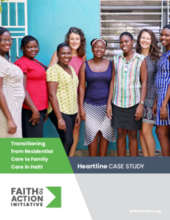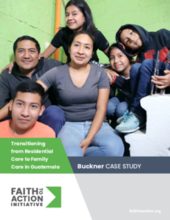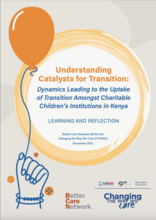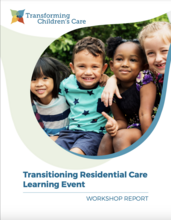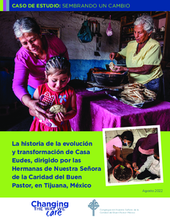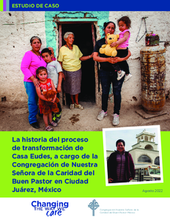What would transition look like for the organisation and based on their context
After looking at the big picture of care reforms, the next step is to zoom in and explore the implications of what transitioning to family care means in context for the individual organisation and their services. Context could include:
- The national context (national laws, policies, government plans),
- The organizational context (vision, mission, stakeholders, history, motivations and partnerships); and
- The local context (cultural and socio-economic)
- The beneficiary context (the situation of children and families the organisation supports)
The aim of this stage is therefore to consider and work through the realities for transitioning to family-based care for the specific organization and reach the point where an in-principle initial decision to progress with a transition can be made by the key decision makers within the organization.
This step is focused on exploration of context and deliberation. Key actions could include:
- Targeted research and learning about the status of child protection and care reforms in the country (national policies, action plans, commitments to care reforms)
- Trainings or workshops
- Discussions and reflections on the organization’s vision/mission/purpose and methodology
- Discussions, Q & As, forums where key decision makers can raise and discuss challenges/concerns
- Reviewing relevant examples of practice from other organizations (from the same country or relevant countries/cultures/contexts) who have undergone transition or who run programs that are viable alternatives to residential care.
- Engaging in or supporting internal advocacy/awareness raising to expand discussions to bring key decision makers on the journey. This may include board presentations or trainings, meetings with key donors, or other staff in key leadership roles.
- Negotiating a preliminary in principle commitment among key stakeholders/decision makers to transition
- Ensuring there is clarity around the high-level objectives of transition and most significant implications for the organisation. This helps create alignment and minimizes future misunderstanding, ensuring key decision makers are all on the same page.
- For those supporting the transition of another organisation, not their own, this is likely to be the time to make an initial visit to the residential care centre to understand the situation of the organization and the residential care service they run.
Topics or issues that may need to be explored and discussed throughout this step include:
- The national context and status of national child protection and care reforms (e.g., government commitments and current laws)
- Short-and long-term implications for the organisation and their services
- The common causes of separation and reasons for admission of children into the residential care facility and current situation of their families (in general terms)
- Existing alternative services and solutions to address the needs of children and families focusing on addressing root causes.
- Differences between rights-based and charitable approaches to programming (including how programs can either contribute to the progressive realization of children’s rights or create conflicts and cause rights regressions)
- What transitioning entails (key elements, phases, timeframes, processes and setting realistic expectations)
- Preliminary questions and concerns regarding transition (overcoming barriers, finding solutions and debunking myths)
- Preliminary cost modelling/projections (forecasting the cost of transition which may be important to get board level agreements to progress)
- Preliminary agreement to progress with transition
- Determination of the key commitments each stakeholder is making throughout the transition and the terms all decision making stakeholders agree to abide by (this is based on their specific roles i.e as a donor, director, board member etc)
The key milestones associated with this step are, the organizations key decision makers have:
- An understanding of the local impetus for change, including the direction the government is moving towards with child protection and care reforms.
- General recognition of the merits of transition in the local context despite acknowledging some of the challenges.
- An in-principal commitment to proceed with transition or more in-depth exploration of transition and progress to the next stages of exploration and planning.
Resources
Displaying 1 - 10 of 18
The story of Heartline’s transition from residential care to family care is told in this recently released Faith to Action case study. The case study details their experience through three stages of transition—learning, preparation and planning, and full transition—with transparency. It addresses common challenges for transitioning organizations, as well as the strategies Heartline took to overcome them.
The story of Buckner Guatemala’s transition from residential care to family care is told in this recently released Faith to Action case study. The case study details their experience through three stages of transition—learning, preparation and planning, and full transition—with transparency. It addresses common challenges for transitioning organizations, as well as the strategies Buckner took to overcome them.
This learning brief was developed as part of the CTWWC 2022 annual report and shares learning from across different contexts. It is intended to showcase how the transition of care services is happening and how it can be supported.
This study was designed to be a small insights-based qualitative learning and reflection study to explore catalysts for transition. It was based on interviews conducted with Charitable Children’s Institutions’ (CCI) directors that sought to identify and explore the range of factors that influenced each director’s decision to transition their residential care services, and the interplay between those factors.
This report captures the key insights, trends, learnings, and participant inputs from the Transitioning Residential Care Services Learning Event held in October 2022 which was organized and hosted by the Transitioning Residential Care Working Group as part of the Transforming Children’s Care Global Collaborative Platform.
This was an interactive workshop organized and hosted by the Transitioning Residential Care Working Group as part of the Transforming Children’s Care Global Collaborative Platform.
Este estudio de caso destaca la transición de servicios de cuidado residencial a los basados en la familia y comunidad, realizado por las Hermanas de Nuestra Señora de la Caridad del Buen Pastor, en Tijuana B.C., México.
This case study highlights the transition of the Sisters of Our Lady of Charity of the Good Shepherd in Tijuana. It presents the highs and lows that come with a change process of moving from residential care to community-based services focused on family strengthening.
Este estudio de caso destaca la transición de servicios de cuidado residencial a los basados en la familia y comunidad las realizado por las Hermanas de Nuestra Señora de la Caridad del Buen Pastor, en Ciudad Juárez, México.

